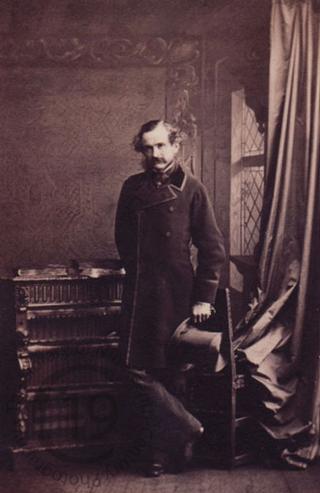
Lieutenant-General Sir William Jervois
A carte-de-visite portrait of Lieutenant-General Sir William Francis Drummond Jervois (1821-1897).
His obituary from the Times (18 August 1897):
‘The death is announced, from a carriage accident, at Bitterne Court, Hants, of Lieutenant-General Sir William Francis Drummond Jervois, G.C.M.G., C.B., F.R.S., Colonel Commandant Royal Engineers, aged 76 years. He was the eldest son of the later General Jervois, and was born at Cowes, in the Isle of Wight, in 1821. He was educated at Dr. Burney’s, Gosport, Woolwich Academy, and entered the Royal Engineers in 1839, becoming captain in 1847, brevet lieutenant-colonel in 1861, colonel in 1872, major-general in 1877, and lieutenant-general in 1882. For seven years from 1841 he was actively employed at the Cape of Good Hope. In 1842 he acted as brigade-major in an expedition against the Boers, and during the three following years was professionally engaged at various frontier stations, making roads, building bridges, and establishing military posts. In 1845, having been appointed acting-adjutant of the Royal Engineers, he accompanied the chief engineer over the whole frontier of the Cape Colony and the settlement of Natal, and in the earlier part of 1846 he was major of brigade in the garrison of Cape Town, until the arrival of Sir Henry Pottinger as Governor and Sir George Berkeley as commander-in-chief, with he proceeded to the frontier against the Kaffirs. During the Kaffir war he made a military survey and map of Kaffiria, a work of great difficulty, in the midst of the military operations. In 1852 he was ordered to the island of Alderney for the purpose of designing plans for the fortifications and the superintendence of their execution, a work strongly advocated by the Duke of Wellington. In 1854 Major Jervois was promoted to the rank of major, and in 1855 he was transferred to the London District, and was nominated by Lord Panmure, a member of a Committee on Barrack Accommodation, whose labours contributed much to the improvements which have of late years been effected in the construction of barracks as well as in the sanitary condition of our troops. In 1856 hew as appointed Assistant Inspector-General of Fortifications under Sir John Burgoyne, and on the appointment in 1859 of a Royal Commission to report upon the defences of the country he was selected by the Government to be secretary. He was at the same time secretary to the Permanent Defence Committee, under the presidency of the Duke of Cambridge. He became the confidential adviser of Lord Palmerston and of several Secretaries of State on matters relating to defence, and designed the fortifications of Portsmouth, Plymouth, Pembroke, Portland, Cork, the Thames, the Medway, and other places. During his long service, nearly 20 year, in the War Office, he was also a member of the Special Committee on the Application of Iron to Ships and Fortifications. In 1861 he attained the rank of lieutenant-colonel, in 1862 was appointed Deputy-Director of Fortifications, and in 1863 was nominated a Companion of the Bath and was sent on a special mission to report on the defences of Canada, Nova Scotia, and New Brunswick, on which occasions he visited the fortifications at the principal ports on the seaboard of the United States. In 1864 he was sent again on a special mission to Canada to confer with the Canadian Government on the question of the defence of the Dominion. On his return to England his report was laid before Parliament, and the Imperial government undertook to carry out the defences of Quebec on the plan recommended by him. He was also sent on special missions to Bermuda, Halifax (N.S.), Malta, and Gibraltar and planned improvement and additions to the fortifications of those places. In 1871-72 he was ordered to India to advise the Government of India respecting the defences of Bombay, Aden, the Hugli, and other places. He was created a Knight Commander of the Order of St. Michael and St. George in 1874, and was appointed Governor of the Straits Settlement in 1875. He held the latter post for two years and during that period he quelled a formidable insurrection in the Malay Peninsula. The subsequent prosperity and quiet of the Malay States resulted mainly from his action. In April, 1877, he appointed to advise the Goverments of the Australian colonies on the defence of the chief ports. While in Australia he was selected to be Governor of South Australia. He was nominated a G.C.M.G. in 1878, and in December, 1882, he was appointed Governor of New Zealand, where, on his advice, the fortification of the principal ports was undertaken by Colonial Government. Throughout his stay in Australasia till the year 1889 he continued to be the chief advisor to the Governments there on matters relating to defence. Since he retired from the public service in 1889 he has strenuously advocated that naval stations and coast defences should be handed over to the Naval Department.’
Photographed on 17 December 1861 by Camille Silvy of London.
Code: 126833




